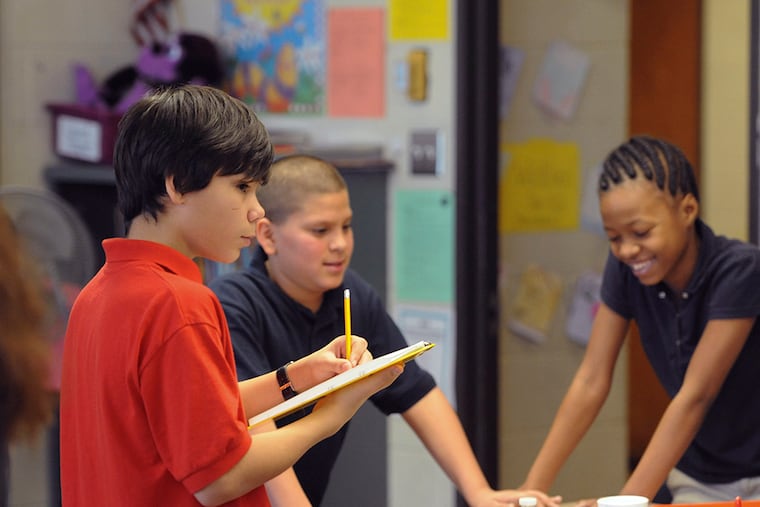Students' voices matter at H.A. Brown Elementary
Clipboards in hand, the walk-through team gathered in the hallway - a woman in a gray suit and five young people in red shirts.

Clipboards in hand, the walk-through team gathered in the hallway - a woman in a gray suit and five young people in red shirts.
"Remember," the team leader said, "we're not interrupting. We're observing."
Fair enough. The team about to evaluate teachers at H.A. Brown Elementary School in Kensington was, after all, comprised of elementary school students.
Student voice is taken seriously at H.A. Brown, a K-8 public school - so seriously that student government members routinely help the principal complete teacher observations. They have chatted up the superintendent and spoken at a citywide principals' meeting, and are booked for a School Reform Commission meeting.
"Many students' opinions are unheard," said Mai Nguyen, eighth grade vice president. "Schools run on just adult opinions. But not here."
That's by design, said principal Connie Carnivale.
The school had no student government when Carnivale arrived three years ago. Changing that was a priority.
"I always want to make sure that learning includes the learners," Carnivale said.
One day last week, Carnivale and five eighth graders visited four classrooms to observe teachers. The walk-through is a precursor to teachers' formal observations, which are done by Carnivale alone, and the students' feedback is designed to help teachers improve their practice.
In Kimberly Brassfield's second-grade classroom, the walk-through team sat and observed first, then circled the room, noting students' work and the teacher's enthusiastic delivery of a vocabulary lesson.
Eighth grade president Tammy Nguyen took careful notes on the same form used by assistant superintendents when they observe teachers.
"Objective is evident," Tammy wrote neatly. "Students do high-order thinking. They say everything together."
In Megan McGlynn's sixth-grade class, the team split up and chatted with students working on social studies projects about the different land forms of North America.
"What kind of land mass is this?" Erydavi Cruz, eighth grade secretary, asked a student painting green grass onto a cardboard box, nodding and examining first his clipboard, then the representation of plains in front of him.
Cruz said later that he had to be honest. Evaluating teachers "makes you a little nervous, because it used to be only adults doing it. It's not easy."
But the students said they take their responsibilities seriously.
"You look for the objective and who's paying attention," eighth-grade treasurer Christopher Reyes said.
"We try to see if they're following the curriculum," Tammy said. "We look for ways to improve instruction."
And they have, Carnivale said. After every walk-through, the team meets to talk about teachers' areas of strength and areas that need attention. And it's not just an exercise, the principal said - the walk-throughs always yield some kind of concrete plan. Student feedback has helped teachers come up with ways to teach tricky math lessons, encouraged more pupils to raise their hands, and helped them come up with better ways to use their interactive whiteboards.
Some teachers - and even some members of her leadership team - were hesitant at the idea of students evaluating them, Carnivale said, but those reservations have disappeared.
"They realized students were really on point," she said. "They felt they came up with realistic ideas."
At monthly student government meetings, Carnivale asks her third- through eighth-grade leaders to help solve problems, such as how to get more students to come to school on half-days. She stresses the solutions must be practical - nothing that would cost money or distract from instruction, for instance.
(Among ideas were that allowing students to dress down or wear crazy hats might do the trick.)
When they have questions or problems, H.A. Brown students are encouraged to tackle them head-on. There were concerns about school lunches, so they met with a representative from the School District's food services department.
The students' efforts have earned the admiration of Superintendent William R. Hite Jr., who visited H.A. Brown at the students' invitation this year.
"They're fantastic kids," Hite said recently. "I can't say enough about the principal and staff."
Like all district schools, H.A. Brown is faced with a brutal budget situation, but Hite likes the direction it's going in. The school faces stiff competition from other schools, but at last count, 42 children whose addresses make charters their neighborhood schools opted to go to H.A. Brown instead.
Hite was so charmed, he asked students to talk about their active student government at a citywide principals' meeting, and to attend an SRC meeting in January.
The students' planned message?
"We want student government in every school," said third grader Sabir Johnson. "That's our goal."